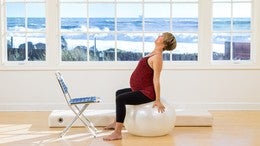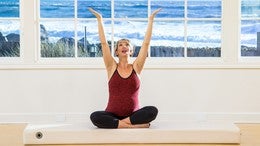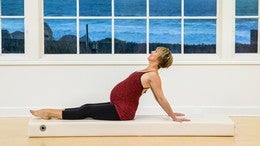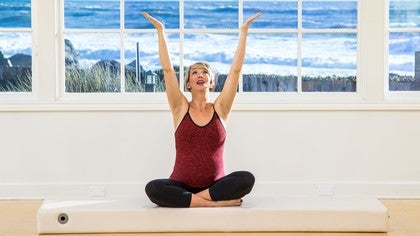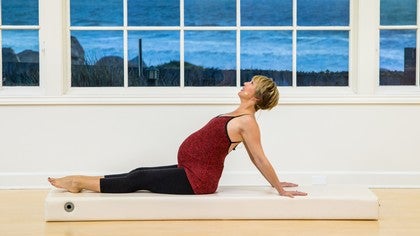Description
About This Video
Transcript
Read Full Transcript
This is our fourth class in a four part series about PyLadies birthing or um, experiencing labor and birth with a Palladio's perspective. And with the help of some of our plots, these tools that we know and love. So this is our, like I said, our fourth class and this is maintaining strong endurance. But before I dive into it, if you're joining me for the first time and you haven't experienced the other three classes, um, or you haven't listened to the introduction to this series, I want you to go back and watching the introductions just to kind of know what the intention is behind this series and you'll really kind of learn what these classes are all about, this four part series. But if you've already done that and you're ready to dive in, let's go ahead and get started. So maintaining strong endurance.
We've talked about our body position options. We've talked about calm and confidence, we talked about the mobility advantage, but there's no denying that strength and endurance are certainly vital aspects and important aspects in the labor and birth experience. Um, oftentimes people will say, uh, going through labor is you can, you can compare it to running a marathon, meaning it requires a lot of endurance inquires, a lot of focus. Inquiry requires a lot of preparation, a lot of determination. And those certainly are all very true elements. But we want to take a look at endurance and there's a couple of different reasons for that is some women have very short labors, some women have very long labors, some women have labors that are go on and off for a weeks time. Um, you know, everybody varies a lot.
And so the level of endurance is going to vary from woman to woman and circumstance, the circumstance. But endurance really has to do with kind of the exhaustive process of the body go through, goes through of the ups and downs of experiencing contractions. And then the culmination of that is after that exhausting experience of going through the ups and downs and contractions is that we have to push a baby out and then once the baby is pushed out, we still have to go through another process of birthing the placenta. So it's a very long process and one that requires a lot of endurance mentally, physically and emotionally. So we have in our prenatal PyLadies series and our practice in our classes, we have the opportunity to kind of maintain or even build in some situations the strength and the endurance that we can need. And then with this specific class, I want to just talk a little bit more about maybe some of the final things that you can do. Um, right before you go into labor, move those final weeks of pregnancy, kind of some small subtle exercises that you can practice the kind of hone in mentally on what endurance means. What I'm going to show you here, you're probably not going to be doing during your labor and pregnancy.
I'm doing like little pushups and little things like that. If you do push ups during your labor and pregnancy, please tell me about it. I'd love to hear about it. But my point is, is now I want to get your muscles prepared, um, to kind of know what that endurance is like. And the key thing about it, in my opinion, kind of some of the things that we're gonna talk about is holding things for 30 to 60 seconds because that's the time of a construction. And then you have a varying time in between your contractions. Um, is this gonna Mimic a contraction? Exactly. No, not at all. But the thing is, is kind of get new mentally in that mindset of what it kind of feels like and what it kind of looks like. So that's my goal. So again, how close I get you to that.
I'm not really sure how much that's going to happen, but I just want to get you mentally in the mind space that we're looking at for some of these endurance qualities. So we're gonna start with some of the upper body work a little bit with the pelvis and then work our way down into our legs. You're also gonna see in this class, um, a lot of the different body positions and body options that we spoke about. So everything kind of, you know, it cross translates and it, it cross references here. So hopefully you'll be able to, um, to re-experience some of those things that we talked about in our previous classes. So let's go ahead and get started. So I want you to come into what I kinda call like a semi kneeling position.
So we get to the hold aspects of it. Um, and I'm going to kind of, sometimes I'll hold for 30 seconds. Sometimes I'll hold for 60 seconds. I'm going to be counting in my head. You can count in your head. I'm going to be doing some breathing while I do that. You can do some breathing and then once IRH to 30 or 60 point, then I'll take you out of the position. So I want you to sit in this comfortable position where your knees are open and you're sitting on your bottom. If you're having issues with your knees, please put a towel or a cushion underneath your heels to give you a little bit more lift or a bolster or anything you have available to you.
If worst comes to worst and you're unable to sit on your knees, you can try this sitting on your bottom and putting your hands forward and that may work for you as well. So we're going to be reaching forward here and we're starting with our shoulders. So we're just going to have a little bit of a tiny, just kind of like a little tiny warm up if you will. So we're going to do a scapula glide. So as I'm pulling my scapula together and pulling them apart. So I'm just going to start here. I'm going to start to warm up those shoulders, activate those shoulders.
But I want you to intentionally in this class I have told you in the past classes in this little four part series to think less about muscle activation and more about just movement. And this class I actually want you to think a little bit more about muscle activation because we're gonna think about when those muscles get a little bit fatigued, how we can kind of embrace that fatigue and worked through that fatigue and not run away from it. I'm not going to push you so far where you're super uncomfortable, but we're just again to introduce this concept to you. So moving forward and back so you can start to feel those muscles warming up. Starting to get a little heat in there and starting to feel that reaction.
So from here we're going to do little tricep presses with the arms, so going down and up. So inhale and exhale. So I want the fingertips really nice and wide. I want the spine nice and strong. I want this mind supported by the abdominals and I really want you to feel that movement, that squeezing coming from the triceps here.
So up and down about three more times using your breath. So we're getting, we're starting to get those muscles a little fatigued and then wants you to hold here and do a little pumps, one, two. So just get those little pumps going, fill those triceps working shit. Start to feel the anterior shoulder working as well. So still doing your little bit of your pumps and do about 10 more keeping your focus and just feeling how those muscles are getting warmer and warmer. Maybe they're starting to fatigue a little bit and then holding here and I want you to hold for 30 seconds.
Use your breath, holding that position halfway there. Keep that holding, embracing that sense of endurance, using your breath to fill the sensation of the muscles and not feel like you want to run away from it. But just to fill that sensation. Three, two, one. Now come halfway up so you're not fully extended and hold there.
And that's kind of what I want to show you in this class in the kind of a more of a mild form. So coming back into that position for me. So you're going to take your right hand behind your head. You're going to do a tricep dip and you're going to rotate towards your left hand an extent. So we can do 10 of these. So we're going to continue to get those muscles a little bit more fatigued. And please forgive me if my account isn't exactly on or my or 60 seconds is in exactly on. So reach
You might feel your arms starting to shake a little bit, might to start to fill that really that discomfort that you're like, okay, I want to be done with this right now and you'll almost star. They just got to hold a little bit longer.
Think about your breasts circulating through your body. About five more seconds.
It's about having something come on and having that, having to experience that endurance and that strength to experience that endurance that you near during and during your contractions in between your contractions and then through those hours where you experienced that up and down of those contractions. Last one, hold little pumps,
You're going to internally rotate your shoulders a bit, and we're going to go down for a little mini push up here. So you're going to go down. One, two, three, push up. One, two, three, down, two, three, one, two, three. So you're feeling your chest open and expand as you go down, up to three, five more. So now you can see how I'm having to have this endurance on my trunk here. So holding my abdominals and my spine and this beautiful coke contraction.
So really feel that I'm supporting my spine as I move my body up and down.
You can start to feel a little bit more in your chest and in the front of your shoulders here as well. So we're just building on that fatigue and acquiring more and more endurance here for that upper body. So about 15 more seconds to hold that they're filling that contraction, using that breath.
You're going to hold even a little bit more. Now push your arms or your hands rather into the mat. So you're engaging your test or engaging your pictorial muscles. You're engaging your anterior shoulders and you're still engaging those triceps and breathe through them.
And one,
Pull your shoulders back, stretch out those elbows and relax here.
They're gonna come on hard and they're going to come on fast. So now we're going to go to the elbows here so much. Should he be parallel here with your hands? You can be parallel with your legs here. So again, more of these pushup kind of positions. So you're going to go here, you're going to push
Let's go a little higher at 30 more for the 62nd contractions. You're a triceps will probably be sore tomorrow.
I'm strength, endurance and press all the way up. So that's going to be some of our endorses that we're going to work through with our upper body. So now I want you to come down all the way forward, create some space for your belly with your knees being out to the side. So now another muscle group that needs some endurance as our upper or spinal muscles. So what we're gonna do here is we're going to lift up and down just a few times. This will be a short little sequence.
Now this spinal endurance is going to come in when we really are thinking about some of the dispositions that we can use to see the position, a squatting position, some positions that are really going to require our spine to be nice and strong, our spine to maybe stay contracted versus in time. Then of course, you're practicing these 32nd holes to mimic some of the fatigue we feel during construct contractions. So we've kind of warmed up the spine a little bit here. So I want you to lift up and I want you to float your hands above your knees. You're going to start in this high position and I want you to hold here. Now, I feel a lot more than my spine working here. I feel my hips, I feel my abdominals. I pull my pelvis, but I'm focusing on that spine. Now notice I'm not straight here, but I'm actually holding a spinal extension or a spinal hyper extended position here and I'm holding.
I'm not pushing against the mat. I'm not using my arms here to help my spine, but I'm really just engaging that spine holding. Of course, I have some leg work going on. Here is my hips are up and I'm using my thighs as well, but I can really feel that work in my spine. So holding that position
Breathing out for four is they're incorporating some of that calming breath that we can do that we learned in our second class in this series, which is our common confidence. Some of that breath. So one more time. We're going to do that sequence. I wants you to hold here and breathe. Now let's practice breathing in for 10 and breathing out for 10
You're gonna reach the palace back and sit down. Now I'm coming a little past neutral and into an extended position here. So XL and down.
Notice how even though I'm getting a lot of energy into my pelvis and my legs, my glutes, I'm keeping my upper body fairly calm. Now this time you're going to hold.
[inaudible]
We kind of recalibrate our bodies a little bit. Even though when we go into, again, our muscles are already fatigued, but that's okay. That's the way that Labor works as well. That's why so often when women get into that, those final stages of labor where the cervix is dilating, those final lesson centimeters is intense. You're already tired, you're already exhausted and it's getting more intense in the body and you just want to quit. You just want to quit. You just want to throw in the towel and be done with it. But you don't have that option cause that's not the way the body works.
So you can't shut down labor like that. So it's gonna keep going. So this is why this is so good to build on top of that layer on the fatigue, on the fatigue on, but Teague and work through that endurance as well. So let's do this series again. So we're going to go up and down
So that's probably what I'm going to do. Um, but or you can certainly mimic the same thing with your theraband under your knees here on what's actually feels kind of good too. But I think I'm going to, um, I'm going to do the seated position. Maybe I'll change it in between so you guys can see both, but sitting in your therabands. So again, here we go. We're going to work into some of that muscle fatigue and into some of that endurance. So make sure it's underneath you so it doesn't come fly up. So we're going to do both arms at the same time in the interest of time for this, while you take this series new start to practice this, I was encourage you to practice doing maybe one arm at a time and as you build up your, uh, your endurance, maybe do right arm, left arm, and then both arms and that's just going to intensify it a little bit more. But just kind of show you the series. So again, grasping what you feel is pretty equal on both sides.
Here we go. You Ready? So we're going to go up and down. I Dunno if I'm ready, but you know what? I'm six and a half weeks out from giving birth for my third time, for at the time of this filming. And these are things I need to start doing and I can feel it naturally and my body kind of like nesting, how women nest prior to labor and having their baby. So I can fill my body needing to work on strength and endurance in a, in a little bit more intentional way than I have been. Um, and preparation mentally and emotionally for what I'm going to have to do for Labor. And then we're gonna hold it. This is where you might start seeing these taken huff and puff.
So we're going to hold her for 30 seconds,
I came across a woman who was trying to teach, um, pregnant women and their partners. What it meant to hold a contraction. And her approach was to have women hold an ice cube. I'm gonna stop for a second, an ice cube in their hands and hold their arm out to the side and they have to hold an ice cube in their hand for 30 to 60 seconds and not move. That sounds pretty simple, right? Try it. Okay. It's, it's, it's pretty uncomfortable to put an ice cube in the palm of your hand and hold it for a minute and then release it. But basically what she likened it to hold and breathe was to that contraction.
And I thought that's such a great idea to kind of in some way simulate what a contraction may feel like. Um, the intensity of a contraction by holding in the ice cube. So holding here about 15 seconds. So as we know though, contractions are about muscles. And so I thought what a great way to kind of be inspired by that idea by using some of our movement in PyLadies in some of our muscular contraction and having to hold release. Some of these isometric contractions that are renewed require us to be static in a moment and to breathe through it. Cause that's what a contraction feels like. It pops up and it's just like beer and it's very static for the time being.
And then it literally just releases. So kind of like when we hold a muscle and then we release it and we just feel that muscle release, that contraction and that's going to be similar to what we're going to feel like with what the contraction during Labor. So it's just really nice to kind of be able to, to understand that. So we're going to go through one more time, side and front, and we're going to work through that endurance one more time.
And then I'm just going to demonstrate real briefly a couple of other positions you can do, but we're not going to actually go through them in the interest of time. So up and down. So I'm really relying on you ladies as you learn this. You can absolutely go through these series with me, but I want you to take some of these simple things like this arm series and start practicing them on your own as well.
And then their final one is you're going to hold back and you're going to draw the scapula together. You're going to activate the rhomboids and the upper back. So that really creates kind of some muscular balance in this series, but it, um, it just adds another dimension. So again, build up with this again, I'll reiterate, you can practice right arm, left arm, both arms, right arm, left arm, both arms, right arm, left arm, both arms. And you can work up to doing that series one time, two times, three times, building that endurance building on top of that fatigue. So that's going to be some of our arms and our soldiers that we can do to, to really, um, help maintain that strong endurance. Okay. So we've gone through some of our shoulder endurance, our an arm endurance, our spinal endurance are a little bit of our leg and our pelvis.
So we kind of worked through some of these. Now the next thing I want to do is kind of mimic a little bit of what I call like a reclined squat or a seated squat position and kind of some of the endurance that's required that because that is a common position, especially in a hospital environment, that women are going to be laboring in and birthing in. So I'm not, I don't have access to getting to a wall at this point, um, to push my legs against. So this is my wall, right? My long boxes, my wall. So I just want you to imagine a wall. If you can practice this by pushing into something that's not going to move a wall, maybe you have a dresser or something accessible to you, um, that you can push your feet into with all of your strains. That's what I want you to look for right now for this really short little series. Um, I'm gonna talk you through this.
I'm not going to be pushing as hard as I can obviously, because I just don't have the stability a provided by the long box here. But I want you to do is I want you to get into a nice seated position with your feet at, against the box, and your, um, are the balls of your feet. Really. Your heels are going to be a little bit away and you're going to be walking your hips forward, holding behind your thighs, and you're gonna use your arms to pull your spine up and a straight up a position as you can. Now in this position, we're going to hold and we're going to start with just activating our hamstrings. You might feel a little bit of your quads as well, just depending on how you engage. But I really want you to think about activating your hamstrings and pushing your feet, pushing your legs as hard as you can into your wall or whatever you're pushing up against. So here we go.
And you're gonna Press and then release. So you're not going to see much movement from me. But as you can see, as I push my body responds by going back a little bit, my knees like extend a tiny, tiny bit. But that's what I want. And then when I release my body comes back in. So push and release. So let's go five more like that. So the reason I'm doing this again is to fill that fatigue in those hamstrings filled with fatigue in the legs, but also to just work on, again, the said, this really common position that women are going to be laboring in and birthing in.
So this summer I want you to hold and I want you to push with all of your might and push and push for 30 seconds. So here's the thing. So you might feel your legs start to shake a little bit. So let's do to hold that. If you're giving birth in a hospital, uh, environment, about 10 more seconds. You might be in this position or some sort of version of this position, most likely reclined a little bit back and go ahead and release it when your legs are going to be up. You might be holding your legs or your birth partner or nurse might be holding your legs for you as you're instructed to push, you're going to be pressing forward with your legs simultaneously.
That's just how the body responds. So you're going to have to, and you're going to be holding that push for a certain amount of time. They usually count down maybe from 10 to one, a little bit shorter. But we want again, be just be prepared mentally for what our body's going to have to endorse. So this requires obviously a lot of flexibility and mobility in your hip joint, but a lot of pressing through your legs as well. So now I want you to lean back a little bit and come into a little bit of a Tuck. I want you to do that again. Push in and release just five this time. Push in
So you can kind of just relay of what that feels like. Um, you can also do one leg at a time, so push the right leg out and push the left leg out. And then you can push both of them and you can do a couple of different variations, but I want you to feel how you tack on to that building on again to that muscle fatigue in the legs. So we're going to go ahead and do one more sequence, kind of a squatting sequence, and we're going to be using a ball. Or if you don't have access to a ball at this point, go grab a chair and you can use a chair as well. So you should have a ball here. If you don't have a ball, you can certainly practice this with a chair, a dining room chair, anything you have accessible to you. Um, I suggest that you may be turned to chair. So the back is facing you so you can hold onto the top of the chair so you can find your support there. So the ball is going to act like a, a support mechanism for us, and we're going to work through some of these squats.
So we all have different capabilities in the flexibility of and the range of motion and our, and our ankle joints and our knee joints and our hip joints. So our squats may look a little bit different. Some of you might be really deep with a vertical spine. If you're like me, I'm kind of somewhere in between with my spine kind of forward. So it really just depends, but I want you to feel the deepest articulation that you can get in those joints. Um, and also just working through some of this, the benefits of some of these squat positions here. So we're going to start in kind of a, a higher position.
So I'm using the ball for that support here. No, if I had a chair, I'd probably be a little bit higher. So we're gonna go three levels here. So we're gonna go one, two, three. Okay.
And then we go ahead and hold into,
Just to kind of calm your energy down a little bit through the intensity of that. So calm your energy down with some movement circles swinging. I'm just going to kind of leave it up to you using your breath. You can feel that trembling through your body, that pulsating of your energy. And we're going to go into it again. So hold, tear 30 seconds.
Embracing your strengths and embracing your endurance, filling your heart rate up as you work through that, using your breath to help you stay calm. And again, in between all of that, you're really using those kind of calming, undulating motions of your body to help your body recuperate. Because what it feels like for that endurance is when the end of labor, you feel that calm and between your contractions and then you can feel the next contraction starting to come on. Then you change your mindset again. You go into that energizing breath focused breath. You go into that imagery, you brace yourself for that journey of that contraction, then you start to feel that contraction release and then you'd go ahead and go back into your calming mode. And it's just this on off, on off cycle the entire time. But again, you know that cycle is so important for the successful birthing of your baby and you know that you've used all of your resources physically, mentally and emotionally that you've gained from Palladia is to help you get through that because you are strong, you do have the strength and you do have the endurance and we can't just rely on, you know, white knuckling through it. We want to prepare our body and the best way that we can so that we can get through that with confidence and with calm. And we know that we've built that strength and that endurance and our body to be able to do that. So again, this class is, could definitely be longer.
We could go through these series more and more. So once you to do this class with me a couple of times, here are my explanations. But then if you really, really want to embrace, says, I would encourage you to start to practice some these sequences on your own. And think of some of the breathing. Think of some of the queuing that I said and use your own internal queuing, your own internal focus. Because when you get in the labor and birthing situation, you're gonna have your birth partner there, of course.
But it's also going to be the messages that you tell yourself in your own mind using your own breath, using your own resolve to help you really embrace the journey that you're going through of labor and birth. Your [inaudible] just aren't going to be there at your burden and teachers aren't going to be there. You're going to have hopefully a breathing partner, but mostly you're going to have yourself and your own confidence. So I hope that you use this class to help you learn how endurance is such a great key for you to get through your labor and birth experience. Thank you so much. And of course, ask me any questions if you have them.
Prenatal Pilates: Pilates Birthing Series
Comments
“Ice hold” they had us practice in my birth class, ha! You are such a wonderful teacher, and helping me feel empowered for my upcoming first birth.
You need to be a subscriber to post a comment.
Please Log In or Create an Account to start your free trial.
